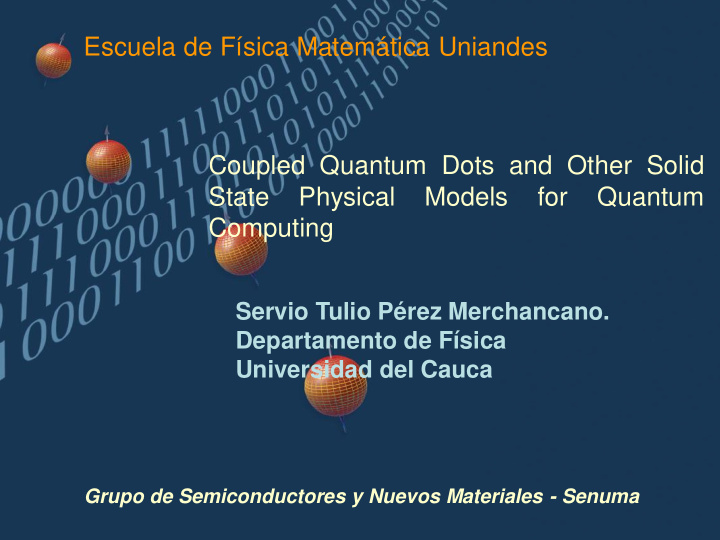



Escuela de Física Matemática Uniandes Coupled Quantum Dots and Other Solid State Physical Models for Quantum Computing Servio Tulio Pérez Merchancano. Departamento de Física Universidad del Cauca Grupo de Semiconductores y Nuevos Materiales - Senuma
INDEX 1. Motivation 2. Quantum Computing 3. Quantum Dots 4. Loss and DiVincenzo models 5. Quantum Dot modelling 6. Spin – Orbit Coupling 7. Energy Exchange in Quantum Dots 8. Quantum dots and optical cavities 9. Spectral Functions 10.Double barrier models in solid state and quantum computing.
ABSTRA TRACT • In this work, the exchange of energy J for a system of two laterally-coupled quantum dots , each one with an electron, is calculated analytically and in a detailed form, considering them as hydrogen-like atoms, under the Heitler-London approach . The atomic orbitals, associated to each quantum dot, are obtained from translation relations, as functions of the Fock- Darwin status. Our results agree with the ones reported by Burkard, Loss and DiVincenzo in their model of quantum gates based on quantum dots, as well as with the recent experimental reports. • On the other hand we have studied other models of quantum tunneling effects that include spin effects that are sources of the entanglement and that, based in solid state physics, contribute to the understanding and potential production of quantum mechanisms.
1. MOTIVATIÓN Addressing and learning even more about a new branch of physics called quantum computation and its application of solid state prototypes for physical realization of quantum computers.
QUANTUM COMPUTING
2. QUANTUM COMPUTING Definition: New model of computation in which the effects described by quantum mechanics for the subatomic world as superposition and entanglement are used as tools for information processing.
2. QUANTUM COMPUTING Features: • The job scenario is not restricted to only two states • Many states appear as a result of the states superposition • This scheme of calculation allows us to evaluate all possibilities in one step = Quantum Parallelism • Polynomial Processing time • Exponential Processing Speed
2. QUANTUM COMPUTING History: 1980s, Introduction of Quantum Computer Concept by Richard Feynman and David Deutsch
2. QUANTUM COMPUTING • 1994 Creation of the Factoring Algorithm by Peter Shor. • 1994 Ignacio Cirac and Peter Zoller of the University of Innsbruck (Austria) proposed the first scheme for the implementing a quantum gate • 1996 Creating of the Search Algorithm by Lov Grover. • 1996 First implementation of the Cirac-Zoller gate by Christopher Monroe and David Wineland at NIST (USA).
2. QUANTUM COMPUTING • 1998 Daniel Loss of the University of Basel (Switzerland) and David DiVincenzo of IBM (USA)proposed the first scheme for the quantum gate construction based on quantum dots. • 2001 Isaac L. Chuang, develops early quantum computers of 2-qubit, 3 - qubit, 5 and 7-qubit qubit using NMR techniques.
1. "Analysis of the Quantum Zeno Effect for 2015-2013 Quantum Control and Computation", J. Phys. A: Math. Theor. 46, 075306 (2013), by J. Dominy, G. Paz-Silva, A.T. Rezakhani, and D.A. Lidar. 2. "Quantum Adiabatic Markovian Master Equations", New J. of Physics 14, 123016 (2012), by T. Albash, S. Boixo, D. Lidar, and P. Zanardi. 3. "Quantum Adiabatic Machine Learning", Quantum Info. Process. 12, 2027 (2013), by K. Pudenz and D. Lidar. 4. "Universality Proof and Analysis of Generalized Nested Uhrig Dynamical Decoupling", J. Math. Phys. 53, 122207 (2012), by W.J. Kuo, G. Quiroz, G. Paz Silva, D. Lidar. 5. "High-Fidelity Adiabatic Quantum Computation via Dynamical Decoupling", Phys. Rev. A 86, 042333 (2012), by G. Quiroz and D. Lidar. [pdf]
2013 1. Magnetically-Defined Qubits on 3D Topological Insulators. Gerson J. Ferreira and Daniel Loss. arXiv:1305.5003 2. Correlations between Majorana fermions through a superconductor. A.A. Zyuzin, Diego Rainis, Jelena Klinovaja, and Daniel Loss. arXiv:1305.4187 . 3. Integer and Fractional Quantum Hall Effect in a Strip of Stripes. Jelena Klinovaja and Daniel Loss. arXiv:1305.1569 4. Topological Edge States and Fractional Quantum Hall Effect from Umklapp Scattering Jelena Klinovaja and Daniel Loss. arXiv:1302.6132
2.1. QUBIT Definition: The smallest unit of information in a quantum mechanical calculating device that describes the quantum state of a two-level quantum system in a Bidimensional Hilbert space. The ket basis of the system are given by
2.1. QUBIT Types: 1-qubit 2-qubit n-qubit
2.1. QUBIT Implementation: Polarized Light Electron spin Photons Nuclear spin Any two level quantum system!!
2.2. QUANTUM GATES Definition: Linear processing unit that performs an operation on a selected set of qubits in a certain period of time.
2.2. QUANTUM GATES 1-qubit: Spin rotation Electronic Spin 2-qubit: Exchange Interaction
2.2. QUANTUM GATES Features : • Infinite number of gates • Any unitary transformation on n qubits can be represented by a set of two quantum gates • Allow reversible computing • Increased thermodynamic efficiency = Minimum power consumption • quantum Parallelism
QUANT ANTUM UM DOTS TS
3. QUANTUM DOTS Definition: nanoscale systems that act as confining box whether particles electrons, holes or excitons. Different Geometries Vertical Confinement Lateral Confinement
1980`s – Optical properties in QDs Nanocrystals and Optical Processes Lateral QDs
3.1. FABRICACIÓN colloidal suspensions: Louis E. Brus Litografic: Mark A. Reed
3.1. FABRICATION 2DEG: Laurens Willems van Beveren and Ronald Hanson en NTT Basic Research Labs, Holland Qubit
Recommend
More recommend